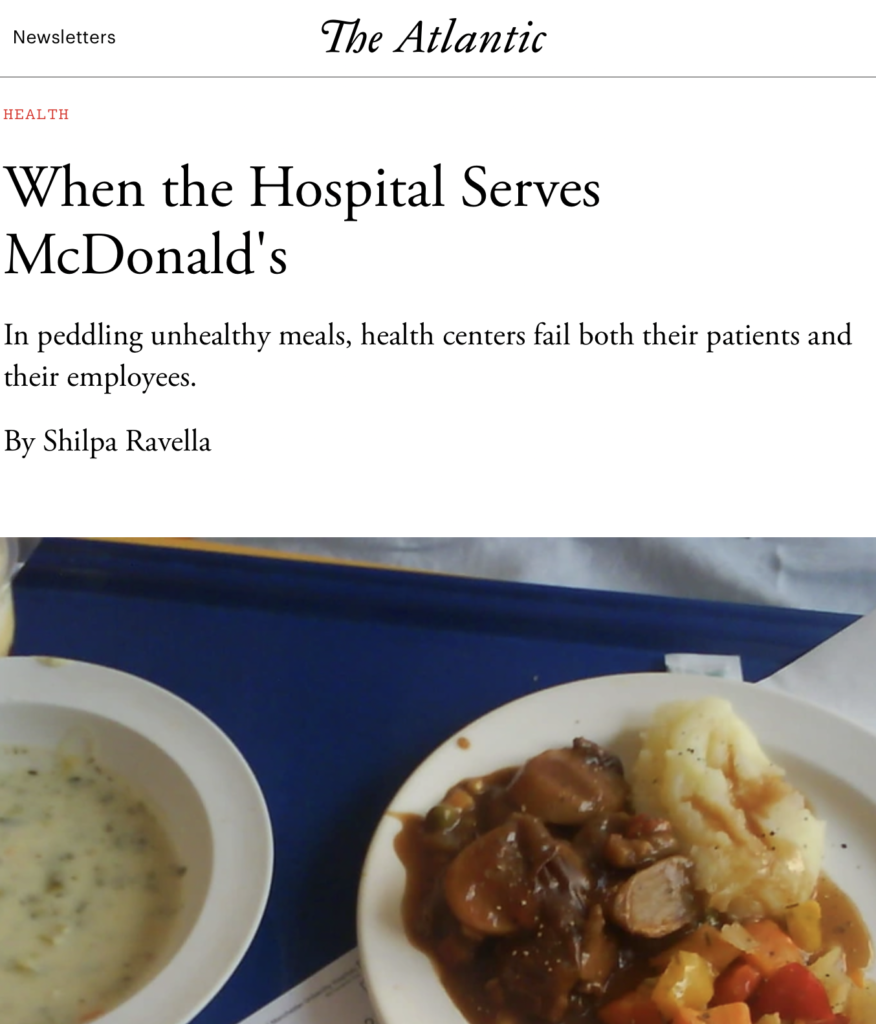February 9, 2016
When I was a medical student doing my clinical rotations around 10 years ago, I regularly ate frozen, re-fried chicken sandwiches from the hospital cafeteria, often while watching anatomy videos depicting body parts that resembled my food. And the closer I came to being a full-fledged doctor, the worse my diet seemed to become: The daily conferences I attended as part of my residency included catered meals that were loaded with sugar, salt, and cholesterol. My fellow residents and I had no problem prescribing drugs for cardiac patients as they dug into a hospital breakfast of bacon, eggs, and hash browns, because it was the same food available to us during our 30-hour shifts. Soon after I began my gastroenterology fellowship in 2010, a crash course in nutrition, I vowed never to leave the house without packing my meals for the day.
The science linking a poor diet to illnesses like heart disease and cancer is robust. This past October, the World Health Organization released a report placing processed meat in the highest-risk category for carcinogens, and declaring red meat “probably carcinogenic.” Meanwhile, the latest dietary guidelines from the U.S. Office of Disease Prevention and Health Promotion emphasized the health value of plant foods.
This fact—a plant-based diet is healthier than a meat-heavy one—isn’t exactly new knowledge. But even as medical researchers discover more about the foods that keep our bodies well, many hospitals continue to serve foods that promote disease. Last year, the Physician’s Committee for Responsible Medicine (PCRM), a nonprofit group composed of 12,000 doctors, issued a damning report about the healthfulness of hospital food in the U.S. Of the 208 hospitals surveyed, 20 percent housed fast-food restaurants like McDonald’s, Chick-fil-A, and Wendy’s on their campuses. And in a study led by Lenard Lesser, a family-medicine physician at the University of California, San Francisco, and an advisor on hospital food environments for the Centers for Disease Control and Prevention, 98 out of 233 university-affiliated teaching hospitals (around 42 percent) had at least one fast-food franchise on campus. Lesser’s findings were similar to another report published in JAMA in 2002, which found that six of the top 16 hospitals in the U.S. housed fast-food establishments.
The food served in regular hospital cafeterias often isn’t much better; in the same 2015 report, PCRM analyzed cafeteria menus and patient meal plans, and found that they often included processed meats and items high in sugar, salt, and cholesterol. Another study from 2012, published in the journal Academic Pediatrics, assessed the food offerings in 14 California children’s hospitals, rating each hospital on a scale from 0 (unhealthy) to 37 (healthy). The average score was 19, and only 7 percent of the 384 entrees served were classified as healthy.
At one point during my gastroenterology fellowship, I cared for a patient who was suffering from Crohn’s disease, which causes inflammation of the gut. He was having bloody diarrhea several times a day; a colonoscopy revealed damaged intestinal membranes, with patchy redness and scattered ulcers. He was still well enough to eat, though, and his appetite didn’t appear to be affected. One day, I came into his room to find him starting on the hospital lunch of the day: chicken wings with hot sauce, creamy mashed potatoes, chocolate cake, and a soda—more or less the opposite of what a patient with gastrointestinal issues should be ingesting.
But remaking hospital menus isn’t easy. Hospitals have to remain fiscally solvent, and many contract with companies that specialize in high volumes of food at a low cost. Often, this means packaged and processed foods are favored over fresh produce. Yet the cost of hospital food is a fraction of the costs hospitals incur when caring for patients, and many of these patients have chronic conditions that can be prevented or treated with diet. Hospitals have incentives to keep patients well and, more broadly, to promote public health as well as the health of their employees.
There have been a handful of success stories in recent years. In 2012, for example, Montefiore Medical Center, the largest health-care provider and employer in the Bronx, eliminated sugary beverages, fried foods, and trans fats across many or all of its locations. The hospital also partnered with fruit and vegetable vendors to hold cooking demonstrations in its clinics. Meanwhile, the Cleveland Clinic recently dissolved a two-decade lease that allows McDonald’s to operate on its property, removed the fryers from its food court, and added healthier options like fresh vegetables and rice bowls.
And not-so-distant history suggests that more sweeping reform is possible. There was a time when doctors walked through hospital wards with a cigarette in one hand and a stethoscope in the other. Once the health dangers of smoking became apparent, though, hospitals were some of the first institutions to ban smoking in public spaces, and other places followed suit. Less than a century ago, it was unheard of to forbid smoking on hospital grounds; today, it’s unheard of to find cigarettes for sale in a hospital gift shop. As Lesser wrote in a 2013 editorial for the American Medical Association Journal of Ethics, “offsets from selling foods that clearly damage human health would, likewise, be indefensible … Serving definitively unhealthful food items to patients, visitors, and staff is simply unethical.” (from The Atlantic)


